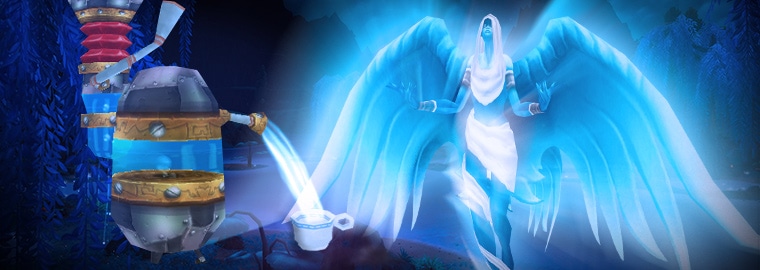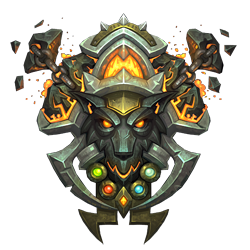As promised Blizzard has come out with a new Watercooler post about health, resilience, battle fatique and healing.


Last week, we talked about squishing stats and pruning unnecessary complexity as part of our ongoing design goals for World of Warcraft: Warlords of Draenor. This time, we’ll look at a few topics all related to one vital element: health.Player Health and Resilience
In the next expansion, we’re planning several interconnected changes designed to provide better-tuned gameplay for healers and improve the healing dynamic in PvP.
The high amount of base Resilience and Battle Fatigue in Mists of Pandaria currently causes characters to feel much weaker in PvP than they do in PvE. To address this disparity, we’re approaching Warlords of Draenor with the goal of shrinking that gap as much as possible. To reduce dependence on Resilience, we needed to increase player survivability against other players, and we chose to do this by essentially doubling (post-squish) player health.
On its own, that increase in health would make players more survivable in the world at large, so we’re also increasing creature damage and the effectiveness of healing spells to balance things out. The net result of these changes is that individual attacks will knock a smaller chunk off of a player’s health pool in PvP, but your survivability in PvE won’t be affected.
Doubling player health gave us room to reduce Resilience and Battle Fatigue, but our goal was to be able to remove them entirely. In order to achieve that, we’re also reducing PvP spike damage across the board by lowering Critical Damage and Critical Heals to 150% of their normal effect (down from 200%).
Our hope is that these changes allow us to reduce Base Resilience and Battle Fatigue to 0%. It’s possible that we’ll still find a need for some minor amount of Base Resilience and/or Battle Fatigue, and we’ll be testing these changes extensively and adjusting as needed.
Retuning Healing Spells
One of our goals for healing in Warlords of Draenor is to tone down the raw throughput of healers relative to the size of player health pools. Currently, as healers and their allies acquire better and better gear, the percentage of a player’s health that any given heal restores increases significantly. As a result, healers are able to refill health bars so fast that we have to make damage more and more “bursty” in order to challenge them. Ideally, we want players to spend some time below full health without having healers feel like the players they’re responsible for are in danger of dying at any moment. We also think that healer gameplay would be more varied, interesting, and skillful if your allies spent more time between 0% and 100%, rather than just getting damaged quickly to low health, forcing the healer to then scramble to get them back to 100% as quickly as possible.
To that end, we’re buffing heals less than we’re increasing creature damage. Heals will be deliberately less potent compared to health pools than before the item squish. Additionally, as gear improves, the scaling rates of health and healing will now be very similar, so the relative power of any given healing spell shouldn’t climb so much over the course of this expansion. For those concerned about what this means for raiding, don’t worry—we’re taking all of these changes into account when designing Raid content for Warlords of Draenor.

It’s also important to note that spells that heal based on a percentage of maximum health are being effectively buffed by the massive increase to player health pools, so we’re lowering those percentages to offset the effect. That may make them appear to have been nerfed—however, the net result is that those percentage-based heals stay about the same as before relative to other heals.
All of these changes apply to damage-absorption shields as well. Additionally, we’re toning down the power of absorbs in general. When they get too strong, absorption effects are often used in place of direct healing instead of as a way to supplement it. We will, of course, take these changes into account when tuning specializations that rely heavily on absorbs, such as Discipline Priests.

We also took a look at healing spells that were passive or auto-targeted (so-called “smart” heals). We want healers to care about who they’re targeting and which heals they’re using, because that makes healer gameplay more interactive and fun. To that end, we’re reducing the healing of many passive and auto-targeted heals, and making smart heals a little less smart. Smart heals will now randomly pick any injured target within range instead of always picking the most injured target. Priority will still be given to players over pets, of course.
Another of our goals for healing in this expansion is to strike a better balance between single-target and multi-target healing spells. We’ve taken a close look at the mana efficiency of our multi-target heals, and in many cases, we’re reducing their efficiency, usually by reducing the amount they heal. Sometimes, but more rarely, raising their mana cost was a better decision. We want players to use multi-target heals, but they should only be better than their single-target equivalents when they heal more than two players without any overhealing. This way, players will face an interesting choice between whether to use a single-target heal or a multi-target heal based on the situation.

Finally, we’re removing the low-throughput, low-mana-cost heals like Nourish, Holy Light, Heal, and Healing Wave, because we think that while they do add complexity, they don’t truly add depth to healing gameplay. (We’re also renaming some spells to re-use those names. For example, Greater Healing Wave is being redubbed Healing Wave.) However, we still want healers to think about their mana when deciding which heal to cast, and so the mana costs and throughputs of many spells are being altered to give players a choice between spells with lower throughput and lower cost versus spells with higher throughput and higher costs. Here are some examples from each healer class:
Druid Higher Efficiency: Healing Touch, Rejuvenation, Efflorescence
Druid Higher Throughput: Regrowth, Wild Growth
Monk Higher Efficiency: Soothing Mist, Renewing Mist
Monk Higher Throughput: Surging Mist, Spinning Crane Kick
Paladin Higher Efficiency: Holy Light, Holy Shock, Word of Glory, Light of Dawn
Paladin Higher Throughput: Flash of Light, Holy Radiance

Priest Higher Efficiency: Greater Heal, Circle of Healing, Prayer of Mending, Holy Nova (new Discipline-only version), Penance
Priest Higher Throughput: Flash Heal, Prayer of Healing
Shaman Higher Efficiency: Healing Wave, Riptide, Healing Rain
Shaman Higher Throughput: Healing Surge, Chain Heal
All of this discussion of efficiency may cause most healers to start worrying about mana regeneration and their mana pool. To allay those concerns, we’ve increased base mana regen a great deal at early gear levels, while having it scale up less at later gear levels. This will make all of these changes play well even in early content such as Heroic Dungeons and the first tier of Raid content, and also play well in the final Raid tier without mana and efficiency becoming irrelevant due to extremely high regeneration values.
That’s a lot of big changes for healers: reduced throughput, more triage, less powerful “smart” heals, weaker absorbs, fewer spells, and a new focus on efficiency decisions. We’re confident that we can apply lessons learned from previous expansions to make this the best healer experience yet: more dynamic, engaging, non-punishing, and frankly a lot more fun.
Instant-Cast Heals
Over time, healers have gained a bigger and bigger arsenal of heals that they can cast while on the move, which removes the inherent cost that movement is intended to have for them, while also limiting players’ ability to counter healing in PvP. This left silences and crowd control (which we’re trying to curb—see “Pruning the Garden of War”) as the only ways to actually limit an enemy player’s healing output. We’re still preserving the option to instantly heal, but are reducing the number of instant-cast healing abilities overall. Here are some examples:
Druid
- Wild Growth (Restoration) now has a 1.5-second cast time.
Monk
- Uplift (Mistweaver) now has a 1.5-second cast time.
Paladin
- Eternal Flame and Word of Glory now each have a 1.5-second cast time when specced Holy.
- Light of Dawn now has a 1.5-second cast time.
Priest
- Cascade, Divine Star, and Halo now each have a 1.5-second cast time.
- Prayer of Mending now has a 1.5-second cast time.
All of these changes taken together are intended to make gameplay more consistent between PvE and PvP, and invigorate healers with more dynamic gameplay.
These are only some of the many changes that you’ll be seeing as we continue development, and what we’ve shared so far is only one piece of a much larger puzzle. We hope that as we share more with you here, on the official site, the forums, and on Twitter, you’ll get a good understanding of what’s to come in Warlords of Draenor and the direction we’re working toward. As always, keep in mind that any of this information could change over the course of the testing process. We look forward to seeing your constructive feedback!



